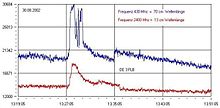Radio weather

Radio weather is the sum of all atmospheric and cosmic conditions that influence the short-term state of the propagation behavior of radio waves . Like the weather , radio weather is defined in the strict physical sense as a specific condition at a specific location on the earth's surface. Certain radio weather conditions can exist in a laboratory as well as over a part of the world without the definition of the term "radio weather" being changed.
General
Radio waves in the short-wave range are reflected by the ionosphere when they hit it at a certain angle. The size of the angle of incidence, which the waves must have so that they are reflected by the ionosphere, depends on the frequency and the ionization (presence of electrically charged particles) of the ionospheric gas. The ionization takes place of the gas molecules in the ionosphere both (generation of electrically charged particles) by ionizing components of the solar radiation as well as by electrically charged elementary particles , as the solar wind to the atmosphere of the earth meet.
The position of the sun initially results in daily and seasonal regularities in the long , medium and short wave propagation . They express themselves differently depending on the frequency range. B. on the properties of the individual amateur radio bands .
Since the strength of solar activity, including the solar wind, depends, among other things, on the eleven-year sunspot cycle , an eleven-year fluctuation cycle in radio weather in the shortwave range can also be clearly observed on Earth. But even short-term fluctuations in solar activity have an impact on shortwave propagation on earth, so that radio weather forecasts are not an easy matter.
Radio services
A radio weather forecast is often useful for radio services in the shortwave range. There are computer programs for this purpose which, after entering the date (for recording the seasonal course) and the current solar activity (e.g. sunspot relative number ), provide a prognosis about the quality of a shortwave connection between two locations, which must also be specified, or which provide a statement about the Meet shortwave coverage of a geographic area.
The shortwave propagation is independent of the state of the troposphere . In the ultra-short wave range and at even shorter wavelengths, however, tropospheric weather also has an influence on radio weather.
In Germany, for example, the Leibniz Institute for Atmospheric Physics in Kühlungsborn is researching the influences on radio weather .
See also
- International Union of Radio Science (URSI)
- Problems and malfunctions in radio technology
- Propagation beacon
- Weather
Web links
- DXRobot - Widespread VHF weather report for amateur radio
- Daily radio weather report for shortwave
- Explanation of the individual components of a radio weather report
- PropWiz - Professional prediction program from Rohde and Schwarz (now free download)
Individual evidence
- ^ Alois Krischke: Rothammels Antennenbuch. 13th edition, DARC Verlag, Baunatal 2013, ISBN 978-3-88692-065-5 , pp. 69-72